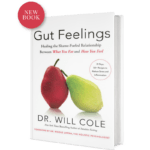What Is The GAPS Protocol? Everything You Need To Know About This Powerful Gut-Healing Tool

As a functional medicine practitioner who talks a lot about gut health, it’s my job to shed light on all the tools available to you to heal your gut. One of these tools being the GAPS diet. This protocol has been used for years to treat symptoms of a damaged gut but has come under criticism for its restrictive nature. So while the GAPS diet may indeed be on the restrictive end when it comes to diets, its foundation is rooted in functional medicine principles of what is good for your gut. Read on to learn more about this diet and whether or not it is a good choice for you and your gut healing journey.
What is the GAPS diet?
Short for Gut and Psychology Syndrome, The GAPS diet is a tool designed to address the connection between your gut and various chronic health conditions. Developed by Dr. Natasha Campbell-McBride, the GAPS diet focuses on healing the gut lining, enhancing microbiome diversity, and reducing inflammation in your digestive system. It revolves around eliminating processed foods, grains, starchy vegetables, and sugars while emphasizing nutrient-dense whole foods. By promoting gut health, the GAPS diet seeks to alleviate symptoms of conditions like autism, ADHD, depression, anxiety, and other chronic ailments associated with a damaged gut lining and bacterial dysbiosis.
The GAPS diet is made up of three stages:
- The Introduction Phase (elimination)
- The Maintenance Phase (the diet itself)
- Reintroduction Phase (transitioning out of the diet)
The Introduction Phase
This phase of the GAPS diet lasts anywhere between three weeks to one year, depending on the severity of your symptoms. It is the most difficult phase of the entire diet because of how restrictive it is in terms of what you are allowed to eat.
The phase is broken up into six stages. You start with a base list of foods in stage one and slowly add in a few more foods as you move through each stage.
- Stage 1: Bone broth, boiled meat or fish, cooked vegetables, ginger and chamomile tea (with raw honey if desired), probiotic-rich fermented foods like yogurt, kefir, and fermented whey, purified water
- Stage 2: Add in organic raw egg yolks, fermented fish, meat and vegetable-based casseroles, homemade ghee
- Stage 3: Add in avocado, fermented vegetables and sauerkraut, scrambled eggs made with ghee, goose, or duck fat, GAPS-recipe pancakes, probiotic supplements
- Stage 4: Add in cold-pressed olive oil, roasted or grilled meats, fresh-pressed carrot juice, GAPS-recipe milkshakes, GAPS-recipe bread
- Stage 5: Add in cooked apple puree, fresh-pressed fruit juice, raw vegetables like lettuce
- Stage 6: Add in raw fruit, raw-peeled apples, baked goods made with dried fruit
In order to determine when it is time to move to the next stage, you must experience normal bowel movements on a consistent basis and tolerate each food in the current stage you are in without any reactions. Once every stage of the introduction phase is complete - however long that takes - you’ll move on to the full GAPS diet, also known as the maintenance phase.
The Maintenance Phase
This phase of the GAPS diet lasts anywhere between 1.5 to 2 years. During this time, you’re diet should only consist of:
- Fish and shellfish (wild-caught whenever possible)
- Animal protein (organic, grass-fed, and pasture-raised whenever possible)
- Vegetables
- Organic eggs
- Fermented foods (kefir, yogurt, sauerkraut)
- Animal fats (duck fat, raw butter, ghee, tallow, lard, etc.)
- Nuts (in moderation)
- GAPS-recipe baked goods (in moderation)
In addition, the GAPS diet recommends that you stick to the following principles throughout the duration of the maintenance phase:
- Choose organic options as much as possible
- Eat as much fermented foods as possible
- Don’t eat meat and fruit together
- Don’t eat pre-packaged or canned foods
- Don’t eat refined carbs
- Don’t eat preservatives, artificial colorings, and additives
One of the biggest recommendations and hallmarks of the GAPS diet is to drink bone broth alongside every meal. Due to its intensive gut healing properties, having bone broth on a regular basis is believed to help speed up the healing benefits of the GAPS diet.
You can also take certain supplements during the GAPS diet including probiotics, digestive enzymes, cod liver oil, and essential fatty acids.
The Reintroduction Phase
Once you have been on the GAPS diet for the recommended 1.5-2 years, it is time to enter the reintroduction phase and start reintroducing foods you haven’t been eating during this time. To determine if you are ready to enter the reintroduction phase, you must be experiencing normal bowel movements and zero digestive distress for a minimum of 6 months.
The length of this phase can vary as you slowly reintroduce foods one by one over a period of time in order to assess for any reactions. Since you aren’t reintroducing foods all at once, and depending on if you have a reaction, this phase can last anywhere between a few months to a year.
Although the GAPS diet doesn’t have a specific order of reintroduction, they do advise that you only eat a small amount of each new food to start and wait 2-3 days before upping your portion size and moving on to the next food you want to reintroduce.
Life after the GAPS diet
After going through each phase of the GAPS diet, you should experience a significant reduction, or reversal, of your symptoms while also curating a diet that works for your specific health case based on the reintroduction phase. Once you know what foods cause a reaction for you, you should continue to avoid them for the foreseeable future while also avoiding processed foods high in sugar. The goal should be to stick to clean, whole-foods as much as possible.
What does the research say about the GAPS diet?
As a functional medicine practitioner, I am often asked about the research surrounding the GAPS protocol. While the GAPS diet is based on the principle of healing the gut-brain axis, it is important to note that there is limited research specifically looking at this protocol. However, studies have explored the link between gut health and various conditions like autism, ADHD, and depression, which are the focus of the GAPS approach. Additionally, research on the benefits of a diet rich in nutrient-dense foods, bone broth, and fermented foods aligns with the GAPS diet's emphasis on gut healing.
Nevertheless, more rigorous clinical trials and long-term studies are necessary to establish the efficacy and safety of the GAPS protocol fully. As with any functional medicine approach, individual responses may vary, and it is crucial to work with a qualified healthcare professional to tailor the GAPS protocol to suit specific needs and health conditions.
The Takeaway
In general, the GAPS diet has a lot of similarities to other gut healing, anti-inflammatory diets including a standard elimination diet and AIP (autoimmune inflammatory protocol). Ultimately, whether or not the GAPS diet is right for you comes down to your individual health case. In my telehealth functional medicine clinic, we run a variety of diagnostic labs to get to the root cause of your chronic symptoms in order to determine the best plan of action to facilitate healing. In some cases, the full GAPS diet might be the right fit, and in other cases some modification may need to be made depending on what is happening beneath the surface.
If you are dealing with chronic health problems and considering a GAPS diet, schedule a telehealth consultation today to learn more about how we can help you using functional medicine. By taking a whole-body approach to wellness, we look at all areas of your health in addition to diet including stress, toxin exposure to come up with a healing plan that works for you and your unique biochemistry.
As one of the first functional medicine telehealth clinics in the world, we provide webcam health consultations for people around the globe.
View More At Our Store
Purchase personally curated supplements
and Dr. Will Cole’s books!

The information on this website has not been evaluated by the Food & Drug Administration or any other medical body. We do not aim to diagnose, treat, cure or prevent any illness or disease. Information is shared for educational purposes only. You must consult your doctor before acting on any content on this website, especially if you are pregnant, nursing, taking medication, or have a medical condition.
Our content may include products that have been independently chosen and recommended by Dr. Will Cole and our editors. If you purchase something mentioned in this article, we may earn a small commission.

BY DR. WILL COLE
Dr. Will Cole, DNM, IFMCP, DC is a leading functional medicine expert who consults people around the globe, starting one of the first functional medicine telehealth centers in the world. Named one of the top 50 functional and integrative doctors in the nation, Dr. Will Cole provides a functional medicine approach for thyroid issues, autoimmune conditions, hormonal imbalances, digestive disorders, and brain problems. He is also the host of the popular The Art of Being Well podcast and the New York Times bestselling author of Intuitive Fasting, Ketotarian, Gut Feelings, and The Inflammation Spectrum.

Gut Feelings
Healing The Shame-Fueled Relationship
Between What You Eat And How You Feel


